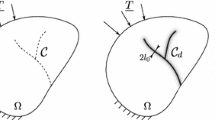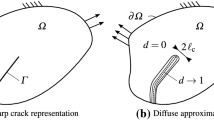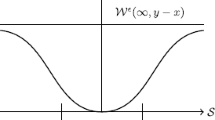Abstract
A non-equilibrium thermodynamics-based evolution model describes the nonsteady, crack propagation rate for both brittle fracture and for viscoplastic behavior at the crack tip. This model for dynamic crack propagation under dynamic or quasi-static loading is developed from an energy functions viewpoint and extends a non-equilibrium thermodynamics construction based on a instantaneous maximum dissipation criterion and a thermodynamic relaxation modulus that permits multi-scale modeling. The evolution equations describing the non-equilibrium fracture process are generated from a generalized energy function whose zero gradient manifold gives the assumed quasi-static crack propagation equations. The class of models produced includes the classical Freund model and a modification that is consistent with the experimental maximum crack velocity. In unstable propagation, the non-equilibrium process is repelled from the quasi-static manifold. If the initial state is stable, then the crack growth process approaches the quasi-static manifold and eventually the crack is arrested. An application of the construction gives the craze growth in PMMA. A simple viscoplastic model for metals predicts the change in temperature at the crack tip as the crack grows.
Similar content being viewed by others
References
Berezovski, A., Maugin, G.A.: On the propagation velocity of a straight brittle crack. Int. J. Fract. 143, 135–142 (2007)
Bernstein, B., Toupin, R.A.: Some properties of the Hessian matrix of a strictly convex function. J. Reine Angew. Math. 210, 65–72 (1962)
Bui, H.D., Ehrlacher, A., Nguyen, Q.S.: Propagation de fissure en thermoélasticité dynamique. J. Méc. 19, 697–723 (1980)
Christensen, R., Miyano, Y.: Deterministic and probabilistic lifetimes from kinetic crack growth-generalized forms. Int. J. Fract. 143, 35–39 (2007)
Dally, J.W., Fourney, W.L., Irwin, G.R.: On the uniqueness of the stress intensity factor—crack velocity relationship. Int. J. Fract. 27, 159–165 (1985)
Döll, W.: Application of an energy balance and an energy method to dynamic crack propagation. Int. J. Fract. 12(4), 595–605 (1976)
Döll, W.: Kinetics of crack tip craze zone before and during fracture. Polym. Eng. Sci. 24(10), 798–808 (1984)
Döll, W., Könczöl, L., Schinker, M.G.: Zur zeit- und temperaturabhängigen Vertreckung von Polymermaterial vor Rißspitzen bei langzeiter statischer Belastung. Colloid Polym. Sci. 259, 171–181 (1981)
Freed, A.D., Walker, K.P.: Viscoplasticity with creep and plasticity bounds. Int. J. Plast. 9, 213–242 (1993)
Freund, L.B.: Dynamic Fracture Mechanics. Cambridge University Press, Cambridge (1990)
Fuller, K.N.G., Fox, P.G., Field, J.E.: The temperature rise at the tip of fast-moving cracks in glassy polymers. Proc. R. Soc. Lond. A 341, 537–557 (1975)
Gao, H.: A theory of local limiting speed in dynamic fracture. J. Mech. Phys. Solids 44, 1453–1474 (1996)
Gibbs, J.W.: A method of geometrical representation of the thermodynamic properties of substances by means of surfaces. In: The Collected Works, vol. 1. Yale University Press, New Haven (1948) (Originally published in Transactions of the Connecticut Academy II, pp. 383–404 (1873))
Griffith, A.A.: The phenomena of rupture and flow in solids. Philos. Trans. R. Soc. Lond. A 221, 163–198 (1920)
Griffith, A.A.: The theory of rupture. In: Proceedings of the First International Congress for Applied Mechanics, Delft, pp. 55–63, 1924
Gurtin, M.E.: Thermodynamics and the Griffith criterion for brittle fracture. Int. J. Solids Struct. 15, 553–560 (1979)
Gurtin, M.E.: Configurational Forces as Basic Concepts of Continuum Physics. Springer, New York (2000)
Haslach, H.W. Jr.: Geometrical structure of the non-equilibrium thermodynamics of homogeneous systems. Rep. Math. Phys. 39, 147–162 (1997)
Haslach, H.W. Jr.: A non-equilibrium thermodynamic geometric structure for thermoviscoplasticity with maximum dissipation. Int. J. Plast. 18, 127–153 (2002)
Haslach, H.W. Jr.: Nonlinear viscoelastic, thermodynamically consistent, models for biological soft tissue. Biomech. Model. Mechanobiol. 3(3), 172–189 (2005)
Haslach, H.W. Jr., Zeng, N.-N.: Maximum dissipation evolution equations for nonlinear thermoviscoelasticity. Int. J. Non-linear Mech. 34, 361–385 (1999)
Hellan, K.: Introduction to Fracture Mechanics. McGraw-Hill, New York (1984)
Lemaitre, J., Chaboche, J.-L.: Mechanics of Solid Materials. Cambridge University Press, Cambridge (1990)
Maugin, G.A.: The Thermomechanics of Plasticity and Fracture. Cambridge University Press, Cambridge (1992)
Muschik, W., Berezovski, A.: Thermodynamic interaction between two discrete systems in non-equilibrium. J. Non-equilib. Thermodyn. 29, 237–255 (2004)
Ogden, R.W.: Non-linear Elastic Deformations. Ellis-Horwood, Chichester (1984)
Ravi-Chandar, K.: Dynamic Fracture. Elsevier, Amsterdam (2004)
Ravi-Chandar, K., Knauss, W.G.: An experimental investigation into dynamic fracture—III. Steady state crack propagation and crack branching. Int. J. Fract. 26, 141–154 (1984)
Rice, J.R.: Thermodynamics of the quasi-static growth of Griffith cracks. J. Mech. Phys. Solids 26, 61–78 (1978)
Slepyan, L.I.: Principle of maximum energy dissipation rate in crack dynamics. J. Mech. Phys. Solids 41, 1019–1033 (1993)
Weichert, R., Schönert, K.: On the temperature rise at the tip of a fast running crack. J. Mech. Phys. Solids 22, 127–133 (1974)
Weichert, R., Schönert, K.: Heat generation at the tip of a moving crack. J. Mech. Phys. Solids 26, 151–161 (1978)
Williams, J.G.: The thermal properties of a plastic zone. Appl. Mater. Res. 4, 104–106 (1965)
Author information
Authors and Affiliations
Corresponding author
Rights and permissions
About this article
Cite this article
Haslach, H.W. A non-equilibrium thermodynamic model for the crack propagation rate. Mech Time-Depend Mater 14, 91–110 (2010). https://doi.org/10.1007/s11043-009-9094-9
Received:
Accepted:
Published:
Issue Date:
DOI: https://doi.org/10.1007/s11043-009-9094-9




